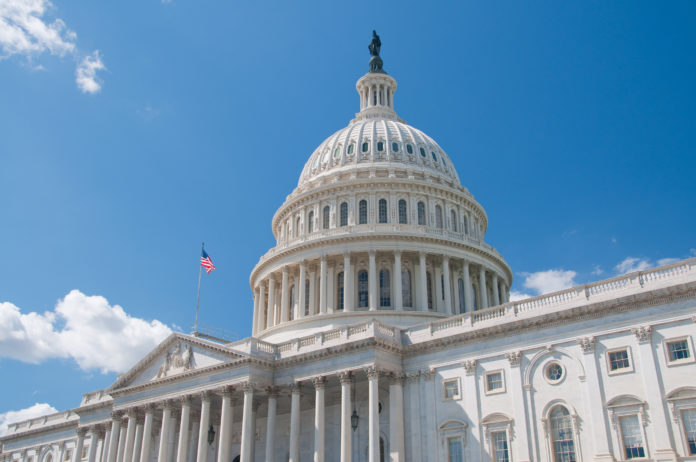Select each title below to read more:
20 State AGs File Lawsuit Saying HHS Staff Cuts Are Unlawful
The reorganization and downsizing of the U.S. Department of Health and Human Services is being challenged by 19 state and the DC attorneys general in a lawsuit filed on May 5 in a Rhode Island court. The state attorneys general allege that the reductions in force are an unlawful dismantling of the agency that prevents remaining staff from carrying out the agency’s statutory functions, which is harming the states. They also claim the RIF actions violate Congressional mandates (including the establishment of the agency and its functions) and a history of Congressional investment in the agency. They note that HHS Secretary Robert F. Kennedy Jr. has admitted that he “knew that possibly twenty percent of the reductions in force (RIFs) were going to be ‘mistakes’ even before the RIFs were executed” and yet pursued them anyway. States expressed their concern that “the consequences are severe, complicated and potentially irreversible.”
DOL Tells Federal Court It Intends to Reconsider 2024 Overtime Rule
The Department of Labor (DOL) stated in a recent filing with the U.S. Fifth Circuit Court of Appeals that it intends to reconsider the overtime rule finalized by the Biden Administration. Published in April 2024, this rule (Defining and Delimiting the Exemptions for Executive, Administrative, Professional, Outside Sales, and Computer Employees) established a two-step increase in the annual salary that must be paid for executive, administrative and professional employees to be classified as exempt from overtime; the first increase took effect July 1, 2024 (rising from $35,568 to $43,888 per year) and the second was scheduled to take effect January 1, 2025 (rising to $58,656). In November 2024, however, the U.S. District Court for the Eastern District of Texas vacated the rule, finding that DOL had exceeded its statutory authority. DOL appealed that ruling and, as the litigation has proceeded, LeadingAge has been watching for a signal about how the Trump Administration views the rule.
On April 24, the Administration filed an unopposed motion with the appellate court to “hold these appeals in abeyance pending the agency’s reconsideration of the rule,” noting the change in Department of Labor leadership. It’s not clear precisely what DOL intends to do; it might decide to issue a new rule that raises the overtime salary threshold from its current level (under regulations effective January 1, 2020), but by a smaller amount than the 2024 rule would have done. LeadingAge will follow this issue closely, but meanwhile the statement to the court appears to be a clear signal that the new Administration is going to walk back the 2024 rule in one way or another.
Review of “Skinny” Budget Request for HHS
The White House issued its “skinny” budget proposal to Congress on May 2 highlighting the Trump administration’s priorities for fiscal year 2026 (FY26), which begins October 1. The skinny budget, which is scant on details, proposes overall spending cuts to non-defense discretionary programs by more than $163 billion, or a 22% reduction from current funding levels across federal agencies. A more detailed FY26 budget request is expected to be transmitted to Congress by the White House in the second half of May. The proposal specifically includes a 26% cut to the Department of Health and Human Services’ (HHS) discretionary budget. Because this budget focuses exclusively on discretionary spending, it does not contain information on mandatory programs like Medicaid, which Congress is currently seeking to cut through the budget reconciliation process.
Many of the funding cuts requested in the skinny budget reflect similar reductions in funding and the elimination or consolidation of programs outlined in the April 10 leaked HHS budget draft. The proposal would reduce funding for the Centers for Disease Control and Prevention (CDC) by $3.5 billion and the National Institutes of Health (NIH) by almost $18 billion, effectively cutting both agencies’ budgets in half. Additional reductions contained in the budget proposal include $674 million for the Centers for Medicare and Medicaid Services (CMS), $1 billion in program cuts to the Substance Abuse and Mental Health Services Administration (SAMHSA), and $1.7 billion in cuts to programs that were formerly a part of Health Resources and Services Administration (HRSA), such as $75 million in education and training programs and $1 billion in health workforce programs. Further, the budget wipes out $4.1 billion from the Low-Income Home Energy Assistance Program (LIHEAP) that helps low-income Americans pay their heating and cooling bills.
HHS Secretary Robert F. Kennedy is scheduled to testify on May 14 before the Senate Health, Education, Labor, and Pensions Committee at a hearing examining the FY26 HHS budget request. LeadingAge will continue to track and analyze the details of the HHS budget request as more information becomes available. Below are more details on the budget process thus far.
Budget Reconciliation Committee Action:
- House Judiciary Committee. On April 30, the House Judiciary Committee passed its portion of the budget reconciliation package in a party-line vote, advancing text that lays out $81.4 billion in new spending on immigration enforcement and deportation efforts. Along with the Homeland Security Committee’s piece of the package, the legislation goes far in helping President Donald Trump advance his tough-on-immigration approach. Among other spending, the text approved by the panel would provide $45 billion to Immigration and Customs Enforcement (ICE) for detention centers, $14.4 billion to ICE for transportation and removal operations and $3 billion for the Office of Refugee Resettlement to house, transport and supervise “unaccompanied alien children.” The measure also includes $8 billion for more ICE agents and personnel, $858 million for retention and signing bonuses for ICE agents and personnel, and $600 million for agency recruitment. As noted in a previous bulletin, the bill also relies on a slate of new and increased immigration-related fees—including those related to visa applications, work authorizations, immigration court proceedings, and form filings—to help offset the cost of the proposed enforcement measures.
- House Financial Services Committee. The House Financial Services Committee complied with budget reconciliation instructions from H.J.Res,14, the House- and Senate-passed fiscal year 2025 budget resolution, and passed a bill on April 30 that would cut $1 billion in federal spending over the next 10 years by changing policies under the jurisdiction of the Committee. The cuts will be packaged with cuts from other committees and used to offset around $1.5 billion (over 10 years) of the $4.5 – $5 trillion cost (over 10 years) of the overall budget reconciliation package, which will extend 2017 tax cuts, create new tax cuts, fund deportations, and provide increased funding for border security. Among the Committee’s cuts is a rescission of all unobligated funding from HUD’s Green and Resilient Retrofit Program. LeadingAge understands this means rescinding GRRP funding HUD would otherwise use for energy benchmarking and the hiring of needed staff to help administer the largest of the GRRP awards, which a judge recently ordered HUD to process and fund after a months’ long pause in the program. It is unclear how much the GRRP cuts will save; the bulk of the Committee’s spending cuts come from deep cuts to the Consumer Financial Protection Bureau. During the Committee markup, Democrats offered 37 amendments, all of which were rejected. Among amendments offered was a broad affordable housing bill from Committee Ranking Member Maxine Waters (D-CA) to increase funding for HUD programs, including more than $500 million program for capital awards, project-based Section 8 rental assistance, service coordinators, and connecting to supportive services and technical assistance for new Section 202 homes. Ranking Member Waters also offered an amendment to fully fund the 60,000 emergency housing vouchers provided during the pandemic and expected to be funded until around 2023 but whose funding is about to run out because rising rental costs used up the programs’ funding much more quickly than expected. “This Committee will do its part to reduce the deficit and decrease direct spending, so that Congress can enact pro-growth tax policies. I am eager to get to work and finally tackle these issues. And remember, today, we are here with one purpose, to do our part to put our nation back on a responsible fiscal trajectory,” Committee Chair French Hill (R-AR) said at the beginning of the markup. Keep up with LeadingAge’s coverage of budget reconciliation in this serial post.
- House Education and Workforce Committee Passes Reconciliation Bill. The House Education and Workforce Committee on April 29 passed the Student Success and Taxpayer Savings Plan, legislation that would cut more than $351 billion over the next decade by making massive reforms to the federal student loan system. These estimated cuts exceed the $330 billion target the Committee was tasked with finding to help pay for President Trump’s package of tax cuts, border security, and energy policies through the budget reconciliation process. According to preliminary estimates from the Congressional Budget Office, $295 billion of those savings would come from repealing existing student loan repayment plans and replacing them with two basic options: a standard plan and an income-based repayment plan. The Committee’s reconciliation bill contains several other provisions to achieve savings, including limiting the size of loans students can take out, eliminating rules that allow borrowers to discharge loans due to a school’s closure or misconduct, eliminating the ability for borrowers to defer their loans based on unemployment or economic hardship, and excluding from the public service loan forgiveness program time spent in a medical or dental residency program. In a positive development, the bill includes the Bipartisan Workforce Pell Act from the last Congress, which LeadingAge supports. This provision would allow Pell Grants to be used for short term training programs, such as those needed by direct care workers, lasting less than the fifteen weeks currently required by the Pell Grant program. The Committee passed the legislation by a party-line vote of 21-14 following the rejection of 34 Democratic amendments seeking to remove many of the bill’s more controversial provisions or requiring certification that they would not harm vulnerable populations, such as low-income students or students at historically Black colleges and universities. The Committee approved bill will be combined with those of other House panels to create a single reconciliation package that will need to be marked up by the Budget Committee before consideration on the House floor. The Committee-passed bill text can be found here. The section-by-section summary can be found here.
- Budget Reconciliation: House Homeland Security Committee. On April 29, the House Homeland Security Committee approved its portion of the budget reconciliation package, containing provisions related to immigration enforcement. In a party line vote, the Committee advanced text that laid out plans for $69 billion in new spending, including $46.5 billion for construction of border barriers, $5 billion for Customs and Border Protection facilities and checkpoints, $4.1 billion to hire and train additional border patrol agents and other personnel, more than $2 billion for annual retention bonuses or signing bonuses to eligible agents, and $600 million for recruiting border security personnel. Democrats offered 34 amendments that sought to put limits on the administration’s policies; all were defeated. Chairman Mark Green (R-TN) promoted the package, stating that the people had elected the Republican majority to approve funds for effective border security and enforcement measures. Many immigration reform advocates believe that meaningful progress will remain out of reach until the administration is confident that its border enforcement objectives have been fully met.
DOL Issues Bulletin with Guidance on Determining Employee or Independent Contractor Status
On May 1 the U.S. Department of Labor’s Wage and Hour Division issued a field assistance bulletin providing guidance to Department field staff on how to determine employee or independent contractor status when enforcing the Fair Labor Standards Act. As noted in this news release, the bulletin directs agency investigators not to apply the stricter analysis contained in the Biden Administration’s 2024 final rule, Employee or Independent Contractor Classification Under the Fair Labor Standards Act – which is also being challenged in federal court – but instead to apply principles laid out in a prior Fact Sheet. The May 1 announcement does not rescind the 2024 rule, but it confirms that the Department is planning changes to that rule, stating: “This approach provides greater clarity for businesses and workers navigating modern work arrangements while legal and regulatory questions are resolved.” LeadingAge will provide additional information in the coming days.
CMS Issues Guidance to Hospital Outpatient Services on Hospice Enrollees
The Centers for Medicare and Medicaid Services (CMS) issued reminders to acute care hospital outpatient services regarding expectations for services renders to hospice enrollees. This follows up on a report from the Office of the Inspector General (OIG) which found that Medicare improperly paid acute-care hospitals for outpatient services provided to hospice enrollees. CMS emphasizes in their latest MLN Newsletter, to avoid improper payments, acute care hospital outpatient services should request and analyze hospice election statement addendums for enrollees they are providing services to. CMS urges providers to review the Acute Care Hospital Inpatient Prospective Payment System educational tool for more information. CMS goes further to outline two important points;
1) CMS does not pay for services given to palliate or manage a terminal illness and related conditions. Services should be provided under arrangements with the hospice provider, and
2) CMS only pays for Part B outpatient services that are unrelated to the terminal illness and related conditions.
This is part of an ongoing effort from CMS to curb spending outside of the hospice benefit including recent updates on the responsibility and liability for providers who do not submit billing with the correct hospice modifiers for services unrelated to the terminal condition.
Weekly Recaps: May 7, 2025
Affordable Housing Weekly Recap. Here is your weekly Affordable Housing Weekly Recap.
Home Health Weekly Recap. Home Health Weekly Recap.
Hospice Weekly Recap. Here is your weekly Hospice Weekly Recap.
Life Plan Community Weekly Recap. Here is your weekly Life Plan Community Recap.
Medicaid, HCBS, and PACE Weekly Recap. Here is your weekly Medicaid, HCBS, and PACE Weekly Recap.
Nursing Home Weekly Recap. Here is your Nursing Home Weekly Recap.




